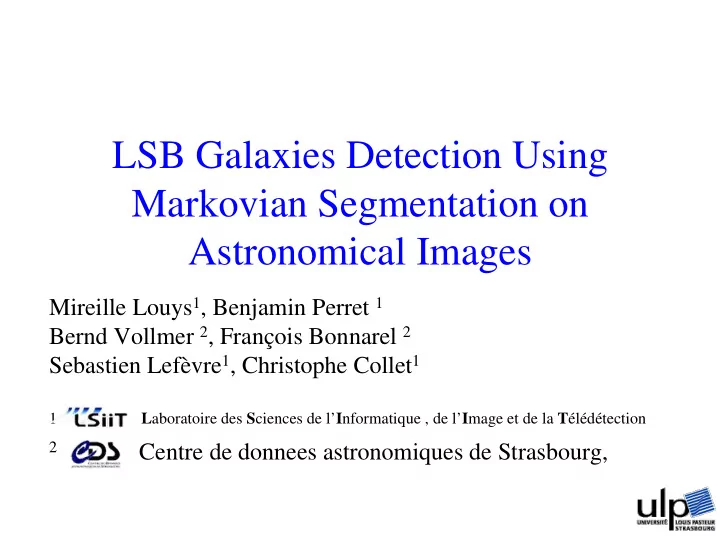

LSB Galaxies Detection Using Markovian Segmentation on Astronomical Images Mireille Louys 1 , Benjamin Perret 1 Bernd Vollmer 2 , François Bonnarel 2 Sebastien Lefèvre 1 , Christophe Collet 1 1 L aboratoire des S ciences de l’ I nformatique , de l’ I mage et de la T élédétection 2 Centre de donnees astronomiques de Strasbourg,
Rationale • Surface brightness is highly variable from one galaxy to another (Disney, 1976) • Low surface brightness galaxies are close to the image background level and satisfy: SB > 22.5 mag.arcsec -2 • Found inside and outside galaxy clusters – How complete are our detections? • More understanding in the baryonic fraction of the Dark Matter in the universe 2
3 More difficult Noise and background Easy case
Overview Original Image Segmentation Map Objects list Visual Objects Profiles Segmentation Selection Inspection and Fitting Validation DetectLSB VO Objects Ellipse parameters list Markovian Quadtree Fit error Magnitude profile LinLog, LinLin VOTable 3D mathematical Measured Surface brightness XML morphology Estimated Surface brightness Scale length
Markovian segmentation • The goal is to classify pixel values and discriminate bright objects, sky background and faint sources to be considered later as LSB candidates . • It works as an inverse method : – Try to find the Bayesian estimate of the most likely class partition that maps the observation – We make 2 assumptions : • on the noise and inner class statistics (here gaussian), • on the statistical phenomenon: Markovian quadtree. 5
Markovian quadtree •The succesive tree levels correspond to increasing scales of the image. •We want to compute the a posteriori probability of having site s in one class c , knowing the observation Ys and the class number of the parent node within the Markov tree. •The Quadtree provides an in-scale regularisation framework, providing exact and non iterative solution •It is fully applicable to multiband observations 6
Steps achieved with DetectLSB • For each detection map: – Identify pixel connected components – Remove very extended components : > 300 pixels – Remove components at the edges of the image • Ellipse fitting • Luminosity profile analysis • Selection criteria: – Sort out stars according to their profile (steep slope, etc.) – Remove bad centered and/or overlaping objects (crowded regions) – Check for central surface brightness 7
Luminosity profile analysis • For each object in the detection map: – Average profile along each ellipse radius f(r)=U 0 *exp( ‐ r/R 0 ) At least 3 points aligned above background level
Source Measurements Fitted Surface Radius Profile Fit SB Brightness Error
Data set • B-images of a region of the Virgo cluster obtained with the Isaac Newton Telescope WFCS (Wild Field Camera Survey) • Analysed by Sabina Sabatini et coll. in SABATINI S.; DAVIES J.; SCARAMELLA R.; SMITH R.; BAES M.; LINDER S.M.; ROBERTS S.; TESTA V. Mon. Not. R. Astron. Soc., 341, 981-992 (2003) . and provided to us as a test set • Full data set = 80 images of 4096x2048 pixels • Analysed: 18 images with X-match with the detection lists provided by the authors 10
Results on the INT data set • Found 79 % of our LSB candidates are confirmed by Sabatini et al. 23 (Markov+detectLSB) compared to 29 (Sabatini) • Found new LSB candidates • The validation on the full data set is still an on-going collaboration effort with S. Sabatini and W. van Driel. 11
Conclusion • The Markovian segmentation approach allows to study LSB candidates even in a noisy environment • Multiband image analysis is beeing currently applied to the same data set in B band completed with I band • First tests are promising • Such a procedure has been implemented in the AIDA image processing workflow project at CDS (Cf Schaaff et al, this conference) 12
2 detections for the same object
Recommend
More recommend